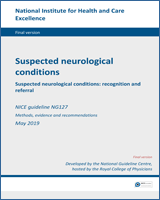NCBI Bookshelf. A service of the National Library of Medicine, National Institutes of Health.
National Guideline Centre (UK). Suspected neurological conditions: recognition and referral. London: National Institute for Health and Care Excellence (NICE); 2019 May. (NICE Guideline, No. 127.)
K.1. Part 1: Adults aged over 16 – signs, symptoms and investigative tests
K.1.1. Dizziness and vertigo including the HINTS test in adults
K.1.1.1. Dizziness and vertigo
Figure 12Serious neurological diagnoses versus other diagnoses – Risk factor: focal examination abnormality
K.1.2. Facial pain, atraumatic
No relevant clinical studies were identified.
K.1.3. Memory failure in adults (Memory tests)
No relevant clinical studies were identified.
K.1.4. Sensory symptoms such as tingling or numbness in adults
No relevant clinical studies were identified.
K.1.5. Tremor in adults
No relevant clinical studies were identified.
K.2. Part 2: Children aged under 16 – signs, symptoms and investigative tests
K.2.1. Blackouts and other paroxysmal events
No relevant clinical studies were identified.
K.2.2. Headache
No relevant clinical studies were identified.
K.2.3. Head shape and size abnormalities
No relevant clinical studies were identified.
K.2.4. Motor developmental delay and unsteadiness (creatine kinase tests)
No relevant clinical studies were identified.
K.2.5. Sensory symptoms such as tingling or numbness in children
No relevant clinical studies were identified.
- Forest plots - Suspected neurological conditionsForest plots - Suspected neurological conditions
Your browsing activity is empty.
Activity recording is turned off.
See more...





